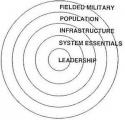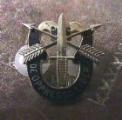We first look to LTG Kiszerly's comments in regard to a portion of the historical development from Jomini to Fuller (the former with little substantial impact on the latter). We then will look to Jomini's Art of War taken as a whole, in its view of strategy and tactics.
1. Historical View of LTG Kiszely
Here we follow the development and expansion of Jomini's concept of "grand tactics" (which we will then show is something of a red herring in this particular historical kettle of fish). So, we proceed to John Kiszely, Thinking about the Operational Level (2005; HT to ML), pp.38-39 (pp. 1-2 pdf; emphasis added and paragraphs subdivided for ease of reading in this post and references to the endnotes, included here as subquotes):
Grand tactics, as defined by Jomini (as opposed to Henderson's and Fuller's later extensions), was based on tactical combinations, which linked tactics to operations and campaigns. Since the latter were expressly part of Jomini's strategy construct, it is true that grand tactics linked tactics and starategy. But, grand tactics were not part of operations and campaigns in Jomini's construct of the "art of war".A level between the tactical and strategic had also been identified by Baron Jomini, writing in the 1830s: a level he termed grand tactics. Jomini was much admired and quoted by many British military writers, such as E. B. Hamley, so that Jomini’s concept of ‘grand tactics’ was well known to the military establishment: for example, at the Staff College where Hamley was the commandant from 1870 to 1878. An instructor there at the end of the nineteenth century was the military historian, Colonel G. F. R. Henderson, who developed his own ideas of ‘grand tactics’ which he defined as ‘the higher art’ of generalship, ‘those stratagems, manoeuvres and devices by which victories are won’.[4]
But the greatest development of thinking in Britain about this level resulted from the work of J. F. C. Fuller. He, too, used the term grand tactics, which, in his 1926 book, The Foundations of the Science of War, he described as ‘the plan of the war or campaign…[which] secures military action by converging all means of waging war towards gaining a decision’. [5]4. Brian Holden Reid, Studies in British Military Thought. Debates with Fuller and Liddel Hart,(Lincoln: University of Nebraska Press, 1996), p.67 & 70.
He subsequently defined grand tactics as ‘the organization and distribution of the fighting forces themselves in order to accomplish the grand strategic plan, or idea’, [6] which is a long way from Jomini’s rather prosaic concept [7] and comes close indeed to our definition of the operational level today.5. J. F. C. Fuller, The Foundations of the Science of War, (London: Hutchinson, 1926) pp 107-108.
6. Holden Reid, op cit, p.65. See Chapter 5 ‘Fuller and the Operational Level’.
7. ‘Grand tactics is the art of posting troops upon the battle field according to the accidents of the ground, of bringing them into action, and the art of fighting upon the ground, in contradistinction to planning upon a map.’ Baron Jomini, The Art of War, (London: Greenhill Books, 1996), p.69. According to Holden Reid, Jomini’s influence on Fuller was ‘negligible’, op cit, p.66.
2. Summary of Jomin's Construct
Jomini's "The Art of War" is sometimes translated as "Summary of the Art of War". The original French ("Précis") may translate better to "handbook" than "summary"; but this relatively slim book was indeed a "summary" of Jomini's military studies and experiences as a staff officer expressed in prior multiple volumes.
The 1862 West Point Preface recommends starting with "Strategy" (Chap III) and then proceeding through the following chapters before returning to Chaps I and II. The first two chapters are concerned with the political and moral aspects of war (more akin to Policy/Politik and National Security Strategy, though those terms absent from Jomini - so also "operational warfare" and the "operational level of war" are absent).
Following the advice from That Place on the Hudson, we will start with Chap III, entitled "Strategy" and subtitled "Definition of Strategy and the Fundamental Principle of War", which begins::
We will follow Jomini's structure in his presentation of the first three "principal parts" of war, Strategy, Grand Tactics and Logistics. We continue with what the "strategic general" does first:The art of war, independently of its political and moral relations, consists of five principal parts, viz: Strategy, Grand Tactics, Logistics, Tactics of the different arms, and the Art of the Engineer. We will treat of the first three branches, and begin by defining them. In order to do this, we will follow the order of procedure of a general when war is first declared, who commences with the points of the highest importance, as a plan of campaign, and afterwards descends to the necessary details. Tactics, on the contrary, begins with details, and ascends to combinations and generalization necessary for the formation and handling of a great army. (p.59)
Jomini then continues with this simplified model war with introduction of a number of "terms of art" that are later much more fully described (pp.60-61). He then lists 13 points that are embraced by strategy (pp.61-62), which define the limits of his purely strategical construct. He also lists "other operations of a mixed nature" (river crossings through winter quarters) "the execution of which belongs to tactics, the conception and arrangement to strategy." (p.62). He also lists the 8 general objects of Grand Tactics (pp.62-63), after reiterating the differences between Strategy, Grand Tactics and Logistics:We will suppose an army taking the field: the first care of its commander should be to agree with the head of the state upon the character of the war: then he must carefully study the theater of war, and select the most suitable base of operations, taking into consideration the frontiers of the state and those of its allies. (p.59)
This introduction ends with the "Fundamental Principle of War" (pp.63-64) - basically: git thar firstest with the mostest.The maneuvering of an army upon the battle-field, and the different formations of troops for attack, constitute Grand Tactics. Logistics is the art of moving armies. It comprises the order and details of marches and camps, and of quartering and supplying troops; in a word, it is the execution of strategical and tactical enterprises.
To repeat. Strategy is the art of making war upon the map, and comprehends the whole theater of operations. Grand Tactics is the art of posting troops upon the battle-field according to the accidents of the ground, of bringing them into action, and the art of fighting upon the ground, in contra-distinction to planning upon a map. Its operations may extend over a field of ten or twelve miles in extent. Logistics comprises the means and arrangements which work out the plans of strategy and tactics. Strategy decides where to act; Logistics brings the troops to this point; Grand Tactics decides the manner of execution and the employment of the troops. (p.62)
The remainder of Chap III is captioned "Of Strategic Operations" (p.65) and is following by Arts. XVI-XXIX, which are expressly concerned witn operations.
Chap IV is titled "Grand Tactics and Battles" and continues in more specifics in Chap VII, “Of the Formation of Troops for Battle, and the Separate or Combined Use of the Three Arms"; again defining Grand Tactics:
Chap V is titled "Of Several Mixed Operations, Which Are in Character Partly Strategical and Partly Tactical".Grand Tactics is the art of making good combinations preliminary to battles, as well as during their progress, The guiding principle in tactical combinations, as in those of startegy, is to bring the mass of the force in hand against a part of the opposing army, and upon that point the possession of which promises the most important results. (p.161)
The foregoing establishes that Jomini separated Strategy (including Operations) from Tactics (where Grand Tactics consisted of tactical combinations); knew Mixed Operations (Strategical-Tactical); and knew Logistics which supported both Strategy and Tactics depending on the context. His "operational art" (which was well developed in his system) was part of his strategical construct, except in a limited number of "Mixed Operations" (where "the execution of which belongs to tactics, the conception and arrangement to strategy"; see p.62).
Regards
Mike





 Reply With Quote
Reply With Quote


 . However I do think CvC meant Fighting (tactics) when he talked means, at least that is my understanding.
. However I do think CvC meant Fighting (tactics) when he talked means, at least that is my understanding.


 - The White House, specifically the Office of the Press Secretary (For Immediate Release, December 01, 2009),
- The White House, specifically the Office of the Press Secretary (For Immediate Release, December 01, 2009), 



Bookmarks